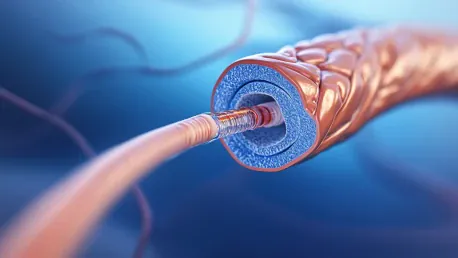Stroke remains one of the leading causes of death worldwide, with ischemic strokes accounting for the majority of cases due to arterial blockages. Each year, over 140,000 Americans succumb to stroke, underscoring the urgent need for improved treatment options. Emboa Medical, a Purdue University-affiliated company, has engineered a novel catheter designed to enhance stroke treatment outcomes by leveraging the unique biomimetic design of a snake’s teeth for efficient blood clot retrieval.
A Novel Approach to Stroke Treatment
The Science Behind TRAP Catheters
The innovative catheter, part of the thrombus retrieval aspiration platform (TRAP), is based on biomimetic principles that enable it to grasp clots more securely without causing additional damage to surrounding tissues. According to Ángel Enríquez, CEO of Emboa Medical, the TRAP design has shown a remarkable 200% improvement in blockage removal force compared to traditional catheters. This substantial enhancement offers a promising alternative to current methods, potentially saving more lives and improving recovery rates for stroke patients.
Expert teams from Goodman Campbell Brain and Spine, NYU Langone Health, and Purdue University’s College of Engineering collaborated to design the TRAP catheter. Upon realizing the potential impact of their invention, they disclosed their findings to Purdue’s Office of Technology Commercialization. This office subsequently filed a patent application and issued a commercialization license to Emboa Medical, marking significant steps toward bringing TRAP catheters to market.
To ensure the catheter’s efficacy, Emboa Medical is working on incorporating microscale structures into the catheter tips. Financial support from the Purdue Innovates Incubator’s Trask Innovation Fund and the CTSI Medtech Incubator has been instrumental in advancing this project. Additional funding exceeding $150,000, sourced from various pitch competitions, has further bolstered the development of the TRAP catheter. These efforts highlight the strong belief in the catheter’s potential to revolutionize stroke treatment.
Addressing the Stroke Challenge
Strokes primarily result from ischemic events, where arterial blockages impede blood flow to critical areas of the brain. Traditional catheters have long been used for clot removal, but their efficacy and safety have often been called into question. The TRAP catheter, however, has demonstrated significant advantages in initial clot removal within worst-case neurovascular models, achieving a 40% success rate compared to 10% for conventional catheters. This striking improvement emphasizes the potential of the TRAP catheter to transform stroke interventions.
Safety and efficacy studies are crucial steps in the journey toward regulatory approval. Emboa Medical plans to conduct an in vivo porcine model study by Q1 2025, aimed at validating TRAP’s safety and efficacy. Successful outcomes from these studies will pave the way for regulatory approval and subsequent integration into clinical practice. The anticipation surrounding these studies reflects the high hopes vested in the TRAP catheter’s potential to offer a safer and more effective stroke treatment option.
Overcoming Traditional Treatment Limitations
Advancements Over Traditional Methods
Traditional stent retrievers have historically been associated with a higher risk of vessel perforation and intracranial hemorrhages due to their metal construction, posing significant challenges to their widespread use. Aspiration catheters, which apply suction to the clot through a tube, are often favored for their lower costs, faster reperfusion times, and reduced risks of vessel injury. However, their effectiveness is limited by the diameter of the vessel, which can restrict successful clot retrieval.
The TRAP catheter is designed to address these limitations and ensure stronger aspiration forces are maintained during clot removal. By incorporating a biomimetic design inspired by snake teeth, TRAP catheters enhance the grip on clots while minimizing the risk of injury to surrounding blood vessels. This innovative approach represents a significant advancement in the field of neurovascular interventions, offering a promising alternative to both stent retrievers and traditional aspiration catheters.
Recognition and Future Prospects
Stroke remains one of the top causes of death worldwide. Ischemic strokes, caused by arterial blockages, make up the majority of these cases. Every year, over 140,000 Americans lose their lives to stroke, highlighting the urgent need for better treatment options. In response, Emboa Medical, a company connected to Purdue University, has developed an innovative catheter designed to improve stroke treatment outcomes. This new device uses a unique design inspired by the teeth of a snake to efficiently retrieve blood clots. The biomimetic approach aims to enhance the effectiveness of clot removal, potentially leading to better survival rates and recovery outcomes for stroke patients. This breakthrough represents a significant step forward in stroke treatment technology, offering hope for reducing the high mortality rates associated with this condition. With continued advancements like these, the medical community moves closer to reducing the toll of strokes and improving the quality of life for many affected by them.









